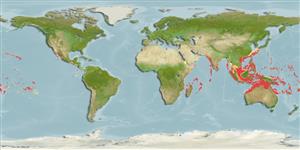Common names from other countries
Environment: milieu / climate zone / depth range / distribution range
Sinh thái học
Biển Cùng sống ở rạn san hô; Mức độ sâu 10 - 216 m (Ref. 37816), usually 10 - 150 m (Ref. 1602). Tropical; 32°N - 23°S
Indo-Pacific: Comoros to the Line, Marquesan and Society islands, north to southern Japan, south to New Caledonia. Recently found in southern Natal, South Africa (Ref. 11228).
Bộ gần gũi / Khối lượng (Trọng lượng) / Age
Maturity: Lm ? range ? - ? cm
Max length : 35.0 cm TL con đực/không giới tính; (Ref. 9710)
Các tia vây lưng cứng (tổng cộng) : 7; Các vây lưng mềm (tổng cộng) : 12 - 13; Tia cứng vây hậu môn: 3; Tia mềm vây hậu môn: 8. Post larvae with large white spots, the spots remaining part of the adult pattern, but become obscured with additional small white spots in the grey areas. The fins remain clear (Ref. 48635).
Sporadic distribution and habitat specific, preferring large coral heads on slopes prone to moderate currents (Ref. 9137, 48635). Adults usually in 20+ m depth; juveniles in shallow lagoons or protected bays (Ref. 48635). Minimum depth reported taken from Ref. 30874.
Life cycle and mating behavior
Maturities | Sự tái sinh sản | Spawnings | Egg(s) | Fecundities | Ấu trùng
Myers, R.F., 1991. Micronesian reef fishes. Second Ed. Coral Graphics, Barrigada, Guam. 298 p. (Ref. 1602)
IUCN Red List Status (Ref. 130435)
CITES (Ref. 128078)
Not Evaluated
Threat to humans
Harmless
Human uses
Các nghề cá: buôn bán nhỏ
Các công cụ
Special reports
Download XML
Các nguồn internet
Estimates based on models
Preferred temperature (Ref.
115969): 21.2 - 29, mean 27.7 (based on 2628 cells).
Phylogenetic diversity index (Ref.
82804): PD
50 = 0.7500 [Uniqueness, from 0.5 = low to 2.0 = high].
Bayesian length-weight: a=0.01148 (0.00451 - 0.02922), b=3.06 (2.84 - 3.28), in cm Total Length, based on LWR estimates for this (Sub)family-body shape (Ref.
93245).
Mức dinh dưỡng (Ref.
69278): 4.0 ±0.66 se; based on food items.
Fishing Vulnerability (Ref.
59153): Low vulnerability (25 of 100).
